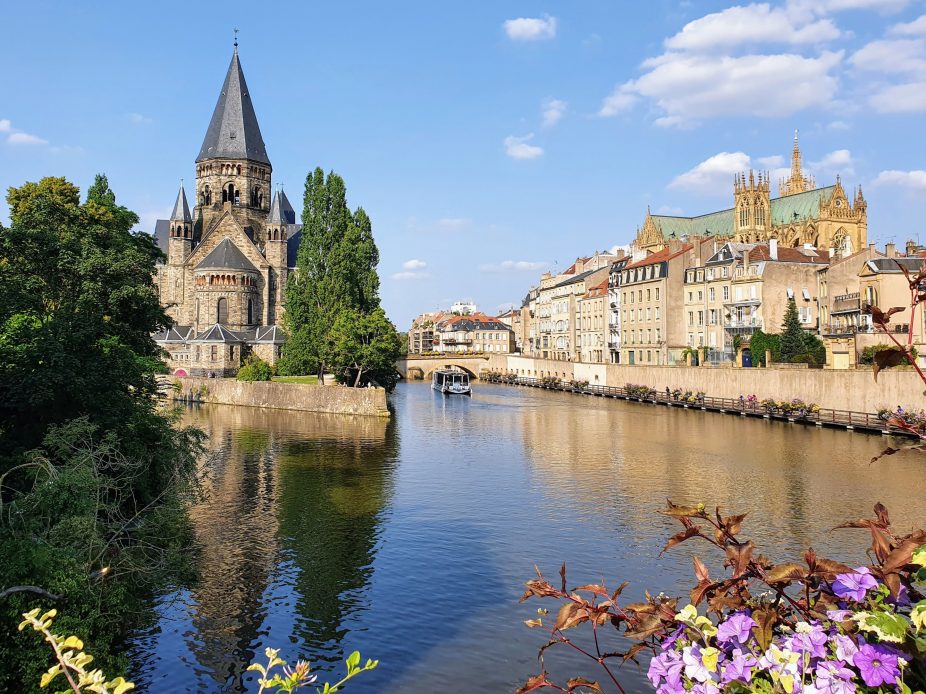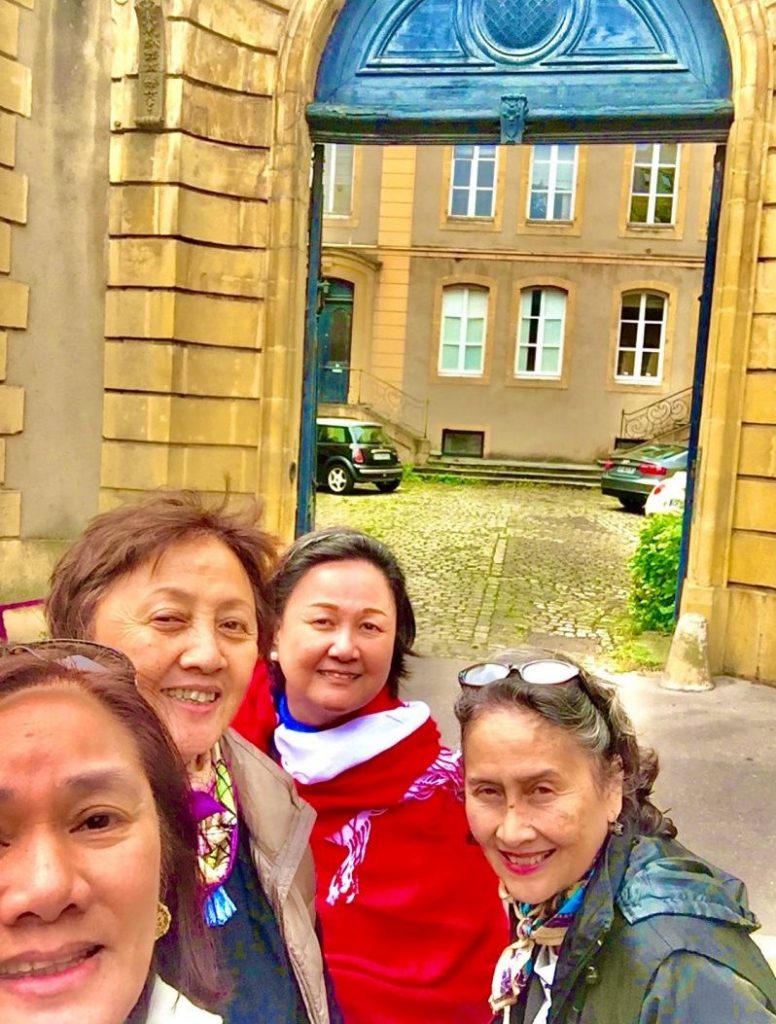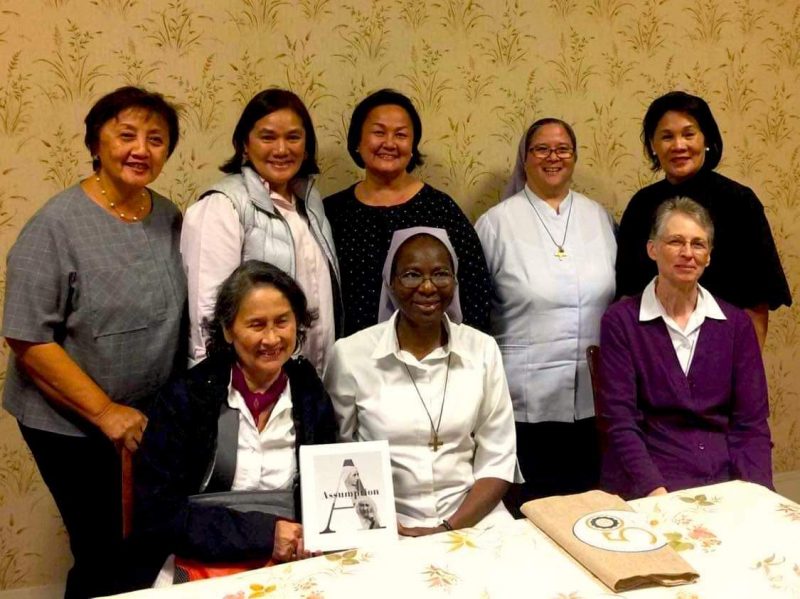HONORING ST. MARIE EUGENIE
5 Assumptionists do France in search of a saint
Rare book traces the footsteps of foundress Saint Marie Eugénie—and serves as guide to a culture, art, even food and shopping experience


The best way to discover a saint is to follow in her footsteps. That was what five optimistic explorers undertook one spring day in Paris, alive with the hope of attaining their mission: to come to know and be familiar with their beloved foundress, Saint Marie Eugénie of Jesus. It was a mission they had not anticipated. They hadn’t started with a plan. But as if guided by unseen influences, they found themselves being led on a journey.

And this is where it started. To celebrate their 50th year since graduating from the Assumption, their alma mater, these “Old Girls”—as Assumption’s alumnae are wont to call themselves—published a nostalgic, whimsical reference book entitled A to Z. It was an encyclopedia of all things Assumption. Exuberant from the cooperative effort which had brought back the camaraderie of high school and college days, high from their jubilee celebration and from the enthusiastic reception the book had received, the group hit on the idea of traveling to France to pay a visit to the Assumption Mother General in Paris and to present her a copy of the book.
So one fine day in June 2017, five old girls boarded a plane to do just that. Little did they realize that their trip was to take on a wider mission than originally conceived.
Their recent reminiscences and focus on Assumption culture and heritage led them to discern that a considerable gap loomed in their cognizance. They realized how little they actually knew about the Religious of the Assumption’s foundress, Saint Marie Eugénie. As students of the Assumption, they’d been taught to hold her in reverence, and they did. But the more they thought about it, the more they realized, what did they really know about her? One of the Wayfarers explains, “As students of the Assumption from grade 1 up to college, we were taught hardly anything about SME, our foundress and saint. Like students of founders St Jean Baptiste de la Salle and Saint Ignatius Loyola, I wanted to understand what moved her to found a congregation that spread like wildfire all over France and to numerous countries in five continents during her lifetime!”
So the Wayfarers traced Saint Marie Eugénie’s footsteps, from her birthplace in Metz in northeastern France, to the Millerets’ country estate in Preisch, a much-contested land where the borders of France, Germany, and Luxembourg all meet. (From the windows of the Millerets’ chateau, all three countries could be seen.)
On the night of 25 August 1817, little Anne-Eugénie was born to Jacques Milleret and Eleonore-Eugénie de Brou. Metz, the political and financial heart of Lorraine, was a city where trade ruled. As such, Jacques Milleret was much respected in this world, by virtue of his being the owner of three banks, an industrialist, a steel manufacturer, and co-founder of the first railway system in the Loire. He was also chief tax collector in the area and had political ambitions to boot. Wife Eleonore-Eugénie came from a family of aristocratic swordsmen with land in Belgium and Luxembourg.
So Anne-Eugénie and her four siblings were raised in considerable comfort and leisure. In Preisch, with their pets, they would adventure in the woods, fields, and streams that marked their 500-acre estate, taming the wild denizen of their shared forests. When indoors, they read and learned from their father’s well-stocked library.
But no vacuous, spoiled children were they. Privilege was coupled with home-bred virtues. Jacques and Eleonore were religiously indifferent, following Catholic traditions out of convention rather than conviction. But they were freethinking and politically progressive, passionate about social justice. Eleonore exposed her children to the world outside the castle walls when she visited the sick and the poor. Anne-Eugénie and her brother Louis enjoyed accompanying her on these works of charity. Their mother taught them the value of self-sacrifice and generosity, honesty and uprightness, virtues which positively marked Eugénie’s character and future vocation.
However, this idyllic childhood was not spared trials. When she was five years old, Eugénie’s older brother Charles, aged nine, died. The following year, her baby sister Elizabeth followed. As a teen, Anne-Eugénie contracted a serious case of typhoid, a disease which threatened her life and whose effects would linger even unto her old age. Prevented from continuing studies at school in Metz, she recovered in Preisch, where her mother home-schooled her and where she devoured books which led her to contemplate on life.

The Assumptionist Wayfarers paying their respects to Assumption foundress Saint Marie Eugenie in the shrine where she is laid to rest behind the Auteuil Chapel

From the book Chronicles of a Wayfarer, a page of a photo of the door leading to the mansion where Saint Marie Eugenie was born, now still unmarked
Our five Wayfarers set out to explore this early world of Anne-Eugénie in the region of Lorraine—through the ancient fortified city of Metz, through two other Milleret family bailiwicks, Thionville and Luxembourg, and finally through Preisch. They surveyed surviving medieval structures and establishments, visiting the churches and chapels where Anne-Eugénie marked spiritual milestones; museums housing medieval artifacts; and modern shopping arcades that once served as the business hubs of 14th century bankers and traders. They learned of the sacred fictions and tales of the land, such as the Graouilly dragon who held the town’s citizens captive with his poisonous breath until they were saved by St. Clement, and of the wily architect, another local mythical hero, who saved the town by outwitting the devil.
All the while, they tried to see through the young Anne-Eugénie’s perceptions, aided by her copious journals and writings.
Perhaps the pinnacle of the Wayfarers’ experiences in Lorraine was gastronomic in nature. Tasting the Quiche Lorraine in its land of origin, they were utterly surprised at its ultralight creaminess and the fact that genuine Quiche Lorraine has no cheese whatsoever. Suffice it to say that there was a lot going on in terms of gustatory delights, couched in abundant superlatives.
In such ecstasies must the young Anne-Eugénie have found herself frequently during her halcyon days. But those days were not to last. As a consequence of the revolution of 1830 which toppled the regime of Charles X and swept Louis Philippe to power, Anne-Eugénie’s father suffered a dramatic turn of fortune. Bankrupt, he was forced to sell the castle in Preisch and give up the apartment in Metz. Eugénie was 13.
Following this downfall, Jacques and Eleonore announced that they were separating. Anne-Eugénie went with Eleonore to Montmartre in Paris; Jacques took his two sons (Eugene and Louis) to Metz. Eugene was considerably older than Anne-Eugénie but Louie, just a year or so older than she, was her bosom buddy with whom she had shared everything, from childhood adventures in the wild to social and political ideas as their awareness increased. It was a bittersweet time for Anne-Eugénie, during which she relished increased closeness to her mother but missed all else that had been near and dear to her. After two years, her mother suddenly got stricken with cholera and, within a few hours, was dead.
Anne-Eugénie was 15 and all alone.
During this period, Anne-Eugénie resided in the homes of family friends and relatives. The first home belonged to a wealthy, worldly friend of her father who offered to take Anne-Eugénie under her wing and teach her to be a lady of good society. Mme. Doulcet immersed the teenager in frivolous Parisian society and was gratified to discover that Anne-Eugénie adapted well to this milieu and was well accepted by the people she was introduced to. But deep inside, the 15-year-old felt isolated and bereft. Her mind roiled with questions, with a need for knowledge and truth that she longed to satisfy. The trials of her early life along with her current suffering had imparted to her a real capacity for self-reflection and analysis.
Then, becoming concerned that Anne-Eugénie was living too frivolous a life, her father sent her to live with a cousin, Mme. Foulon, who turned out to be on the other side of the scale: so pious and narrow-minded as to dangerously repulse the teen from the things of God. But Mme. Foulon’s piety turned out for the good. Her connections helped secure seats to the crowded and very popular Notre Dame Lenten Conferences of 1836. Here, Anne-Eugénie listened raptly to Henri Lacordaire, a celebrated social reformer who was attracting hordes of followers. It was then that her ultimate conversion occurred, and when she often credited her vocation to have started.
Anne-Eugénie had received intimations of the holy path she was destined for as far back as age 12, during her First Holy Communion. But it was here, while listening to this man of God, that she truly discovered Christ and His Church; here she made the decision to give her life thoroughly to God.
Paris of the 19th century was a place of turmoil and innovation, of great revolutionary upheavals. In less than a hundred years, Paris saw the rise and fall of five regimes, two revolutions, a war, and an urban insurrection. Aside from uproar, world-transforming inventions were emerging: the railroad, the telegraph, the electric light, photography. Europe was industrializing, and consequently, the gap between the social classes was expanding. And the exploitation of women and children was becoming a bitter fact of life. Meanwhile, the arts, sciences, and technology were metamorphosing. The literary market was expanding due to advances in the printing technology. The ideas of authors such as Balzac, Flaubert, Sand, Hugo, and Zola, many of whom portrayed the world without illusions and in all its sordidness, were illuminating societal change. In the arts, painters like Monet, Manet, Pissarro, Degas, Braque, and Renoir were flaunting a radical art style called Impressionism, which rebelled against the classical and sought to reflect the world in which they lived. In religion, the Church was losing its traditional privileges and becoming more exposed to attacks from the humanists and socialists. Out of defensiveness and fear, it often reacted in reactionary ways. However, social reformers like Lammenais and Combalot were inspiring young Catholics to transform society towards holiness and the kingdom of God. Truly, it was an era in search of balance.
It was the era in which lived Anne-Eugénie, who was fired up by the ideas of the young Catholics. In those years after the French Revolution and in the early days of the Industrial Revolution, she was aware of both the superficiality of the affluent and the miseries of the poor; her dream was to transform this society. She longed to work for the Kingdom of God in a society where no one would have to endure the oppression of others. Through it all, Paris was turning from a medieval city into a modern capital with a public transit system and a public school system.
However, schools for boys were common; not so schools for girls. Anne-Eugenie adopted the burning desire of her first mentor, Fr. Combalot, which was to found a congregation with a strict contemplative life but that would also do the work of educating women. They believed that society’s regeneration would be accomplished by women.
This is what Chronicles of a Wayfarer: Finding Saint Marie Eugenie depicts in a collage of pictures, vignettes, and commentary. The Wayfarers weave their way through the path of a fearful young woman, raised in an irreligious background, filled with doubts and insecurities, through her formation as a resolute leader and a redoubtable saint. The book points out the key players and influences in her life, the tests faced by the young congregation, and the epoch’s political and religious conflicts.
Her story is weighty. But in following its broad overarching path, the Wayfarers take readers through a most unique and delightful route, stopping by such out-of-the-way spots as La Fontaine Medicis at Le Jardin de Luxembourg or the flower and bird markets in Ile de la Cité that regular tourists never even get a whiff of.
While charting the steady footsteps of Saint Marie Eugénie, one can savor the finest local food treats which the intrepid Wayfarers tested during their moments of respite; there’s top-notch pork from 98 Cul de Cochon, excellent Escargot a la Bourguignone at 38 Rue Montorgueil, delicious pastry at Pierre Hermé, 72 rue Bonaparte.
The book can help succeeding pilgrims find a fresh harvest of fish and crustaceans, a wide selection of wines, cheeses from every part of France, Italy, Spain, Greece, and Portugal, and even ice cream cocktails. Can’t select one type of bread or the other? No worries; in the tiny gem of a book tucked away in your coat pocket, you’ll find an encyclopedia of French breads to help you choose. For those with more specialized shopping goals, you can discover where to get vintage designer eyewear (No. 10 Passage du Grand Cerf), cosmetics at great discounts (City-Pharma, 24 rue de Four), antiquarian books, prints and postcards (J.C. Martinez, 21 rue Saint-Sulpice), and religious articles by French, Greek, Italian, and German craftsmen.
In 1839, at 15 rue Ferou, Anne-Eugénie and her fellow pioneers of the Assumption set off on their great adventure. It was here that the community started with four young women, short of experience but unwavering in their faith in God’s will for their lives. The Wayfarers introduce you to this cradle of the Assumption, a historical and literary street where in more recent times, real life artist Man Ray lived; other artists such as Jean Cocteau, Marcel Duchamp, Max Ernst frequented his place. Ernest Hemingway resided for a time at Rue Ferou. Earlier on, Lavoisier, the father of modern chemistry, hid out from the terrors of Robespierre (of French Revolution fame) at IX Rue Ferou. This quaint street seems to have been a magnet for adventurers, poets, screenwriters, actors, and creatives of all sorts, including fictional characters such as the musketeer Athos (of the Three Musketeers).

Visiting the Assumption Mother House in Auteuil, Paris, with Sister Stella Sanz
But Anne-Eugénie and her community were to move many more times: to Meudon, a town in the outskirts of the city, now a suburb between Paris and Versailles; to rue de Vaugirard (in Paris again) where the sisters took on their new names—here Anne-Eugénie became Marie Eugénie of Jesus—and the purple habits that distinguished their group; to Impasse des Vignes, an ancient vineyard in the Latin Quarter where they had a novitiate and a boarding school; to Chaillot in the vicinity of the Champs Elysées where they were to remain for 12 years; and finally Auteuil, where to this day the Mother House is located and where the beloved saint is buried.
The book provides a lovely précis of each of these areas, replete with fabulous photos and maps of varying details and cultural information. It cites each area’s landmarks, sights, restaurants, transportation, routes, and activities. There’s a map of the Latin Quarter that marks the shops, restaurants, art cinema houses, bookstores, museums, gardens, and other places to visit that you don’t want to miss. And, of course, there are churches, a plethora of them, but especially the three great churches where Saint Marie Eugénie nourished her faith: Notre Dame, Saint-Sulpice, and Saint-Eustache with their stained glass windows, sculpture, furniture, works of art, and historical highlights.
Her life, as well as the Congregation’s, was volatile and full of challenges, much as the era it was born in. Marie Eugénie remained steadfast and placid in the midst of affronts and indignities. In the early hours of the 10th of March, 1898, she died peacefully, surrounded by her sisters. At the time of her death, there were 1,100 Assumption sisters and the Congregation was established in four European countries, in Nicaragua in Central America, and in the Philippines in Asia: a total of 29 communities (including four in England). Today, worldwide, there are over 1,200 sisters in 207 communities in 34 countries.
In 1975, Marie Eugenie of Jesus was beatified by Pope Paul VI. She was canonized by Pope Benedict XVI on 3 June 2007.
The five Wayfarers were mesmerized by all that they learned of the times and life of their foundress and saint. In following in her footsteps, they discovered the mettle of this woman. “It boggles the mind how she was able to survive all the misfortunes and trials that were heaped upon her, and to found a congregation that spread like wildfire all over France and numerous countries,” says one Wayfarer. So now they would like to take other Assumption alumnae and interested parties on a pilgrimage tour to France, much like what they’d done.
The Alliance Française, with the Embassy of France to the Philippines in Manila, is promoting this pilgrimage tour to France, especially because 2022 marks the establishment of 75 years of diplomatic ties between France and the Philippines.

Chateau de Preisch, where Sister Marie Eugénie spent most of her childhood (CTTO)
Not ready to rest on their laurels, the Wayfarers have taken on one more mission for themselves. “The Foundress of our Alma Mater did not even have a marker to indicate her place of birth!” laments one of the Wayfarers. “So we promised ourselves to do something about it upon our return. In fact we are now applying for permits to install markers in her birthplace in Metz, at the site of her baptism at the Ste. Madeleine family chapel situated right next to the Chateau de Preisch, as well as the site of her First Holy Communion at the Ste. Segolene, a church in Metz.”
Way to go, Wayfarers!!

The chapel in Lubeck where co-foundress Therese Emmanuel is buried
With thanks and appreciation to The Diarist.ph for their gracious permission in allowing us to reprint this fetured article.
Copyright © 2025 Assumption Alumnae Association
